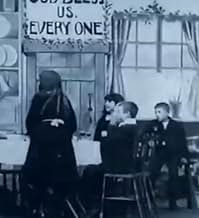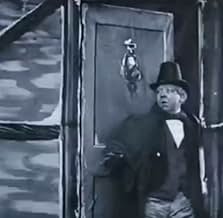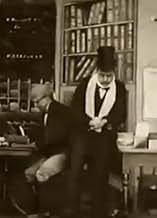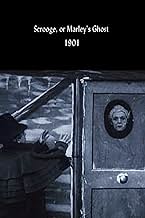Nowadays, we often take for granted the approach, grammar and techniques that make up self-contained narrative movies. This seems to have been a natural advancement, but it was actually a difficult problem to early filmmakers. Many hesitated to even edit together spatially separate shots to tell a story for concerns that it would seem discontinuous. In "Scrooge; or Marley's Ghost", Walter Booth and R.W. Paul approached this problem by using a story that a general audience already knew, but abridged it, explained some finer points in the intertitles and packaged it within the tableaux style. Perhaps, a lecturer would even provide further clarification during an exhibition. Several other filmmakers tried this as well, including Cecil Hepworth with "Alice in Wonderland" (1903) and Edwin S. Porter with "Uncle Tom's Cabin" (1903). The earliest and most common films of this kind, however, were the passion plays. Another early story film James White's "Love and War" (1899) was accompanied by explanatory song. This kind of filmic storytelling soon became outdated in comparison to, but for a time coexisted with, the story film, especially the chase films, which established continuity editing. Of course, novels would still be abridged, intertitles would occasionally do too much of the work, and the tableaux style continued in some places, but films became self-contained narratives. Therefore, this film is outdated, but it does have some interesting aspects.
This is perhaps the earliest screen adaptation of Charles Dickens' "A Christmas Carol". Apparently, there were earlier film versions of other Dickens' stories, but according to the British Film Institute, this is the earliest that survives. Ewan Davidson for the BFI further adds that it was based on a play by J.C. Buckstone, which like the film, dispensed with the different ghosts for a condensed vision provided by Marley's ghost. Additionally, Dickens, with this book, was one of the more important 19th Century writers to invent the family-oriented, charitable and gift-giving Christmas holiday that we know today. Likewise, this film is an early example of a Christmas film released during the season.
This was an elaborate film for 1901; originally, it supposedly contained 13 scenes. What remains is less than five minutes with about six scenes in their entirety and a brief glimpse of another scene. In what remains, there are some novel techniques for the time. There are multiple exposure shots for the ghosts, but this effect had already been done in previous films; this is, however, the earliest instance that I've seen of using the multiple exposure effect for overlapping images with title cards. This is also an early use of title cards in general, although they had appeared less elaborately in a few earlier films, including "How It Feels to Be Run Over" (1900). Furthermore, this is the first instance I've seen of the wipe, which transitions between shots. Dissolves are also used, which is a transition effect that Georges Méliès had already established in his films. Scenes are also tinted.



















